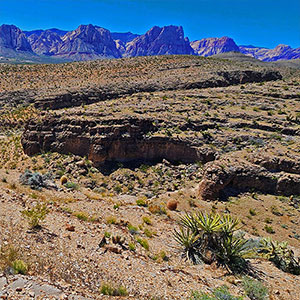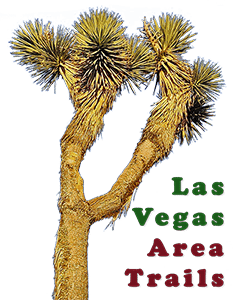









































Adventure Slide Guide will appear here during the week of 4/21/2024
Though it’s not the Bermuda Triangle, the Blue Diamond Hill Southern Triangle has a few twists, turns and challenges along with majestic limestone cliffs, hidden caves and spectacular views. I summited Blue Diamond Hill 3 times in order to work out this route!
The Blue Diamond Hill Southern Triangle is an upside-down triangular formation of two main canyons. It’s located off Highway 159 just East of the Blue Diamond Hill Gypsum Mine Road and just to the Northwest of the town of Blue Diamond.
Beginning from the Wheeler Camp Spring trailhead parking area, cross Highway 159 and head Northeast to the first canyon wash East of the Blue Diamond Hill Gypsum Mine Road. Head up the wash which rapidly deepens with towering walls on either side. Soon you’ll see a huge canyon split. This is the apex of the upside-down triangle. Take the left split up to the summit area of Blue Diamond Hill just before the canyon ends at the Blue Diamond Hill Gypsum Mine Road. Turn right (East) at the top of the canyon to skirt the edge of the Blue Diamond Hill Gypsum Mine property. This is the rough base of the upside-down triangle. Descend into the next large canyon to the East (more majestic and huge than the first canyon). Take that canyon back down to the apex of the triangle (the original canyon split) and then return to Highway 159 and to your starting point at the Wheeler Camp Spring trailhead area.
The above route description is the simplest route. As you can see on the map on this page, I added to the route, ascending Blue Diamond Hill 3 times by the end of the day and finally descending a historic road on a ridge that arrived at Highway 159 directly across from the main entrance to the town of Blue Diamond! More about that later.
You’ll see majestic towering limestone cliffs on either side of the canyons as they narrow and widen along the way. Close observation of the cliffs revealed at least 10 limestone caves. Some could be reached by walking up steep inclines. Others were high up on the limestone cliffs and would require advanced rock climbing skills, equipment and experience. There are non-stop Southwestern desert gardens at every point including sage, numerous varieties of cacti, yucca, Joshua trees and wild flowers to mention just a few. The area will likely be in full bloom during early May. It’s amazing! When you reach the high points you will see spectacular panoramic views of the entire Rainbow Mountain Range along with Potosi Mountain to the South and Red Rock Canyon and the La Madre Mountains ridgeline to the North. There will be great views of the Gypsum Mine operation. You’ll come across faint, historic roads and trails.
It’s all a class 2 walk, a bit steep in places, but still a walk. There are a few light rock scrambles and one pretty hefty dry fall (about 50ft) you can ascend or descend at a class 3+ level of difficulty. When I first encountered this barrier it turned me around and back up the canyon. I circled around and entered the canyon from below to check out the base of the dry fall barrier (see the video). From below it looked easier than from above, so I climbed up the dry fall, headed back up to the summit of the canyon and finally descended an old, historic road on a ridgeline.
You could likely make it through the dry fall barrier, but realize it will take some careful rock scrambling down some brief but near vertical 10-15ft stretches. On the other hand, you could keep the whole adventure at a class 2 level and just turn around at the dry fall and head up the canyon again and descend by the upper ridge road as I did on one of my passes. Either way, this adventure is well worth it! By the way, that larger canyon below the dry fall is choked by brush, thorns and boulders. It’s fun in its own way, but I skipped it the second time around and felt it easier instead to head all the way back up to the summit of the canyon and descend by the ridge rather than face the lower tangle of obstacles a second time!
Stick to Fall through Spring. Mid-Summer temperatures can easily exceed 110 degrees! During the Winter, on the few days when it’s around or below 35 degrees in the Las Vegas Valley and raining, there could be ice and snow making the adventure hazardous. Avoid the Blue Diamond Hill Southern Triangle within 24-48 hours of the last rain as the rocky sections are hazardous when wet.
Take the Charleston Blvd. exit off Hwy 215 in Las Vegas. Head up Highway 159 toward the mountains (Red Rock Canyon). You’ll pass Calico Basin, the Red Rock Canyon scenic drive entrance and exit. Continue on Highway 159 past the Oak Creek and First Creek trailheads. Continue past Spring Mountains State Park and Bonnie Springs. Just before the Gypsum Mining road branches off to the left, watch carefully for the Wheeler Camp Spring trailhead parking area on the right. It’s not marked and easy to miss.
Beginning from the Wheeler Camp Spring trailhead area, cross Highway 159. There’s a long barbed-wire animal barrier along the entire length of Highway 159. One of the few easy openings in the barrier is at the Blue Diamond Gypsum Mine Road across Highway 159 just a bit to the right (West) of Wheeler Camp Spring. Cross the barrier fence at that point and begin to angle upward to the right (Northwest) heading for the first low ridgeline and canyon wash just beyond. Don’t go too high on the ridge or you’ll miss the descent slope into the canyon wash. Further up the wash is bordered by tall limestone cliffs making descent into the wash impossible.
Once in the canyon wash, take a left up the wash. The sides of the canyon soon rise to towering limestone cliffs, but the wash you’re in is wide, flat and easy to navigate. You’ll almost immediately notice the hectic sounds of Highway 159, not far below, are no longer to be heard and for the remainder of the canyon triangle adventure it’s like you’re in another world. It’s a completely peaceful wilderness setting and you’ll feel your a thousand miles from civilization!
Soon you’ll reach a major split in the canyon. This is the apex of the upside-down canyon triangle. Keep to your left as you continue to ascend the canyon. The Blue Diamond Hill Gypsum Mine Road is on the ridgeline above to your left (West). You’ll pass a couple branching canyons to the right (East). If you have lots of time you could explore these branching canyons. I explored one of the branching canyons from above. At the entrance of each is a hill with a beautiful barrel cactus garden! Take some time to ascend the hill and walk among the huge cacti. Then, return to the main canyon wash and continue ascending the canyon until its upper end meets up with the Blue Diamond Hill Gypsum Mine Road.
Take a right (East) up a hill at the canyon summit just short of the Blue Diamond Gypsum Mine Road. Now you’ll skirt the lower edge of the Blue Diamond Gypsum Mine property as you watch for the next major canyon to descend. There’s an unpaved road just South of the mine property that will aid your progress for a bit. The surrounding panoramic views of the Rainbow Mountains and other landmarks are spectacular here.
Soon you’ll reach the huge descent canyon. There is a smaller branching canyon to the right. That’s too soon. Wait until you’re high enough on the summit of Blue Diamond Hill that you can look down and see the town of Blue Diamond below to the South and you can look to far to the East beyond Blue Diamond Hill. From this high point, you will need the next large descent canyon…the one that will lead you back down to the apex of the upside-down canyon triangle.
This is the largest, most spectacular canyon in the triangle. Here’s where you will see 10 or more good-sized cave openings in the towering limestone walls. The wash itself is fairly wide with a gradual descent. It’s a beautiful walk with some interesting limestone blocks (just a few feet tall, like huge steps) to descend along the way. Total peace and tranquility! The only sounds are hawks and ravens soaring the cliffs above. The canyon alternately narrows and widens in some interesting twists and turns. You’ll hear your voice echoing off the cliff walls.
About 2/3rds of the way down the canyon you’ll finally reach a huge dry fall barrier. It looks most imposing from above. There are a few large terrace levels, and you can’t see around the corner ahead to know that if you descend one level you might be faced with another steeper level you cannot descend. You could end up being trapped with a near vertical section above and below! My approach is never to descend a section I am not sure I can re-ascend if faced with a lower, larger barrier cliff. So, on this day I returned up the canyon, circled around and ascended the canyon from below to the base of that barrier. The good news is that I discovered it was very possible to descend the barrier. You won’t get trapped between ledges! You don’t have to re-ascend the canyon like I did. Just keep descending.
The re-ascent was fast and easy. No problem! Once again at the canyon summit, I took the Eastern (right) upper edge of the canon back down to its upside-down triangle base. The descent was actually fun with great views of the canyon from far above, knowing I’d just been down there. On the ridgeline, there was a curious unpaved road no longer in use. More about that later.
From below, at the apex of the upside-down canyon triangle, the lower third of the canyon is much more complicated than the upper 2/3rds above the barrier. There is thick brush and thorns to navigate, along with boulders. There is a short 10ft near vertical ledge with a smooth, marble-like surface making for a difficult ascent. More caves in the limestone walls! Finally, there you are at the base of the large barrier that stopped me from above. Yes, it’s a steep, smooth-rock, tall barrier to climb, but not horribly hard, and no significant vertical exposure. The reason I went ahead and climbed the barrier is that it seemed easier to head all the way to the summit of the canyon than to descend the tangled lower third! And it was easier. And I wanted to check out the upper ridgeline road.
That upper ridgeline heads down to its base directly across from the main entrance to the town of Blue Diamond. And, there’s an unused road the full length of that ridge, leading me to imagine this was the historic Blue Diamond Mine Road. I can imagine people from the town of Blue Diamond, possibly originally established to support the mining operation, driving up that road to the mine. The huge chute on the West side of Blue Diamond Hill was originally used to send the gypsum oar downward. Today it seems large semi-trucks transport the oar down the hill on the newer main Blue Diamond Hill Gypsum Mine Road. This is all just a theory based on logical observation.
At any rate, the ridgeline descent back to Highway 159 was wide-open with a spectacular view all around. The road made it an easier, welcome change from the earlier canyon wanderings. And it was restful while being lightning fast! Note the black line on the map on this page.
At the base of the ridgeline, at the edge of Highway 159, turn right and parallel the highway until you find a way through the barbed wire fence. Not that the lower strand of the fence has no barbs and there are a few places to squeeze under. But, even if you don’t get through the fence, you’ll arrive back at the Blue Diamond Hill Mine Road within about a quarter-mile where you can cross over highway 159 and back into the Wheeler Camp Spring trailhead parking area.
This adventure quickly places you in what feels like a remote wilderness area. It’s great fun to explore. You might even check out one of the many caves, though I can’t vouch for the caves and what might possibly be inside! As you explore the canyons, you can always easily ascend to their upper end where you can descend open ridgelines back to Highway 159. You’re never far from civilization, though it feels remote. Easily choose the length of your adventure!



Return often to experience one new adventure each week! From the home page scroll to “Most Recent Adventures“. More about David Smith…
The trail adventures on this website require proper conditioning, preparation and safety precautions. There are many factors beyond our control including weather conditions, unstable ground, loose rocks, insects and snakes, people you may encounter, your own level of physical conditioning, the potential of getting lost just to mention a few. While this site offers guidance, helpful tips, direction and training, the reader assumes full responsibility for whatever may occur during their trail adventure. Have fun and be safe!